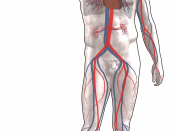The main body systems of the frog are the digestive system, circulatory system, urogenital system, excretory, respiratory, and the frog's skeleton and muscles. The frog digestive system starts in the mouth. Prey, which is sometimes caught by the frog's sticky tongue, is diced by structures in the mouth that are tooth-like. The food then travels down the esophagus, into the stomach, where, the food is softened, somewhat broken down, and then stored. This will take place by mechanical digestive because of the ruggae in the frog's stomach. From the stomach, food moves into the small intestine, where the most of the chemical digestion, (by the pancreatic juices of pancreatin, secretin, and insulin, and bile from the liver) and nutrient absorption take place. One special feature of the frog's small intestine is that it has villi, which are small projections that greatly increase the surface area of the small intestine, which leads to more nutrient absorption.
Wastes which are not absorbed by the small intestine enter the large intestine, where the water in them is taken out. The wastes exit through the cloaca, the common exit of the digestive, reproductive, and excretory systems in the frog. Liquid wastes will also exit through the cloaca. That is how both the digestive and excretory systems of a frog work.
There are two upper chambers of the heart, the right atrium and the left atrium. The frog heart, however, has only one lower chamber, a single ventricle. In humans, the lower chamber of the heart is divided into two compartments, the right ventricle and the left ventricle. Oxygenated blood and deoxygenated blood containing waste gases are present at the same time in the frog all the time. The oxygenated and deoxygenated bloods do not mix. Mixing is prevented by a unique arrangement of...


